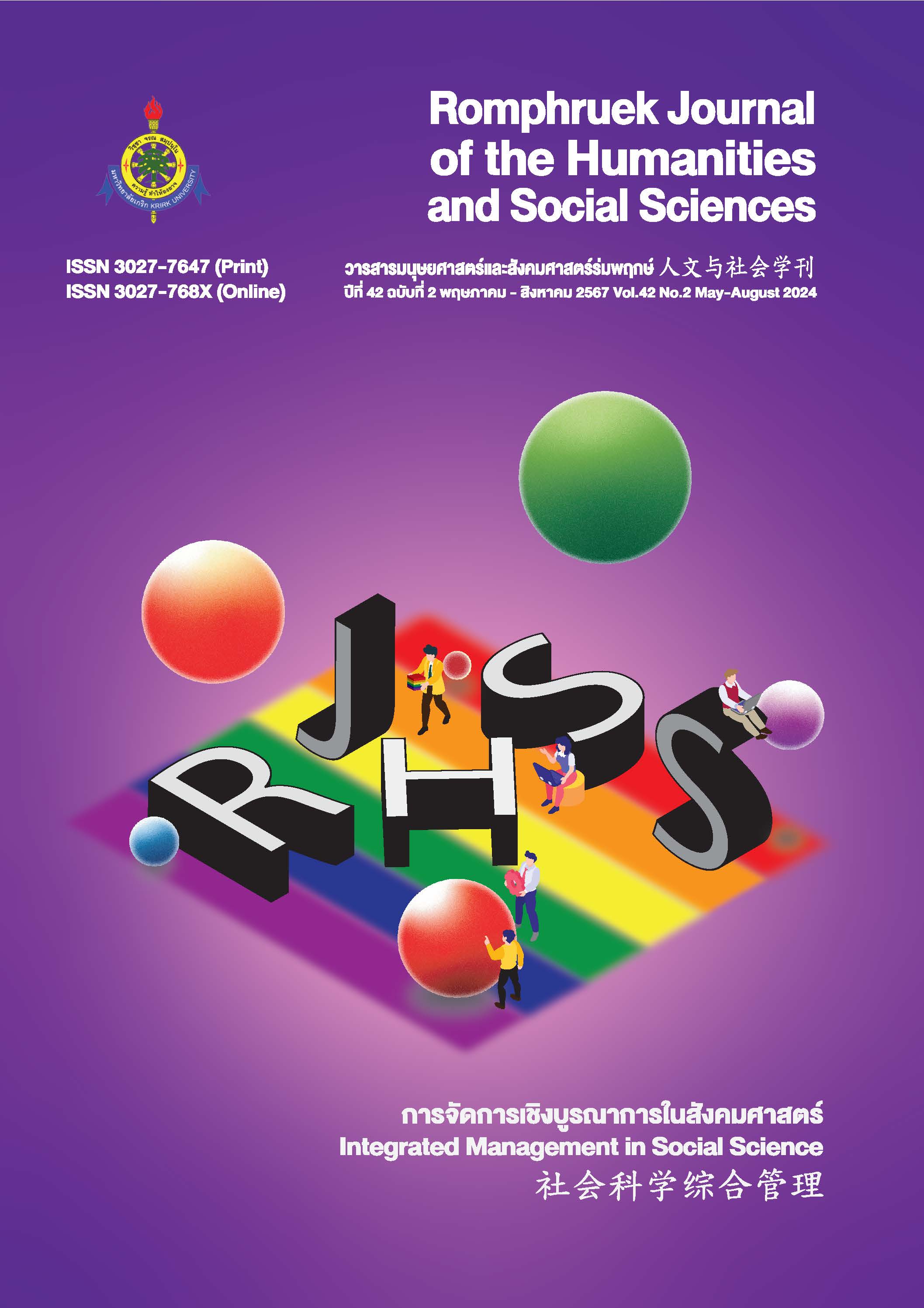Quality Level and Factors Affecting to Intention and Satisfaction of Using the “MohPrompt” System: A Case Study in Bangkok
Main Article Content
Abstract
The “MohPrompt” application is a system developed by the Ministry of Public Health of Thailand to communicate information of the coronavirus disease 2019 (COVID-19) in Thailand and to administer the COVID-19 vaccine to the public. The “MohPrompt” application, therefore, is a one-stop-service system that covers the service of booking appointments, reporting side effects after vaccination, and requesting vaccination certificates. The objectives of this study are to 1) examine the level of quality affecting user intention to use and satisfaction on the “MohPrompt” application in Bangkok, 2) analyze the factors influencing the user’s intention to use and satisfaction on the “MohPrompt” application in Bangkok, and 3) collect suggestions to develop the quality of the “MohPrompt” application.
This study employed a quantitative research approach. The population was 6.5 M users who used the application in Bangkok with 400 samples calculated from Yamane (1973) formula. A multi-stage sampling method was used to collect data. The statistics used for this research were percentages, means, standard deviations, influence coefficient (), and squared Multiple Correlation (R2) with the structural equation modeling (SEM) based on the research conceptual framework at the significance level of .05.
The results showed that the mean level of quality factors affecting user intention to use and satisfaction with the “MohPrompt” application in Bangkok were high (mean = 3.75). When considering each level of quality, it was found that all levels of quality’s means were high: Information Quality (IQ) mean = 3.90, Data Quality (DQ) mean = 3.86, System Quality (SQ) mean = 3.78, Net Benefit (NET) mean = 3.77, Perception Security Privacy (PSP) mean = 3.67, User Satisfaction (SAT) mean = 3.66, and Intention to Use (USE) mean = 3.62 (lowest). However, it was revealed that only 8 out of 10 factors had statistically significant influence coefficients () at the .05 level. In other words, Perception Security Privacy (PSP), Information quality factors (IQ), and Data quality factors (DQ) had an impact on the quality that affected the intention to use the system (USE) with influence coefficients (
) of 0.42, 0.37, and 0.19, respectively with the R2 of 0.59. Furthermore, Information quality factors (IQ), Perception Security Privacy (PSP), and Data quality factors (DQ) had an impact on the quality that affected system satisfaction (SAT) with influence coefficients (
) of 0.42, 0.41, and 0.17 respectively with the R2 of 0.64. While The USE and SAT factors influenced the quality that affected the perceived net benefits (NET), with an influence coefficient (b) of 0.29 and 0.92 respectively. Nevertheless, two factors that did not have statistically significant influence coefficients (
) at the .05 level were system quality (SQ) having no influence on the quality that affected the intention to use the system (USE) with an influence coefficient (
) of 0.09 (P = 0.178) and system quality (SQ) having no influence on the quality that affected the satisfaction of using the system (SAT) with an influence coefficient (b) of 0.11 (P = 0.077).
Article Details

This work is licensed under a Creative Commons Attribution-NonCommercial-NoDerivatives 4.0 International License.
Every article published in the Romphruek Journal of the Humanities and Social Sciences is the opinion and point of view of the authors. Thery're not the viewpoint of Krirk University or the editored department. Any part or all of the articles for pablication must be clearly cited.
References
กรรณิการ์ คงทอง. (2561). ความตั้งใจเชิงพฤติกรรมในการใช้เทคโนโลยีของกลุ่ม เจเนอเรชั่นเบบี้บูมเมอร์ และเจเนอเรชั่นเอ็กซ์ (วิทยานิพนธ์หลักสูตรบริหารธุรกิจมหาบัณฑิต ไม่ได้ตีพิมพ์). มหาวิทยาลัยเทคโนโลยีราชมงคลกรุงเทพ.
จิรภัทร มิขันหมาก. (2564). ปัจจัยที่ส่งผลต่อการยอมรับการใช้แอปพลิเคชั่นเป๋าตัง. การนำเสนอผลงานวิจัยระดับชาติ ด้านวิทยาศาสตร์และเทคโนโลยี ครั้งที่ 4 วันที่ 17 ธันวาคม 2565 ณ มหาวิทยาลัยราชภัฏจันทรเกษม กรุงเทพฯ, 103-108.
พิมพ์ปวีณ์ มะณีวงค์. (2563). ปัจจัยที่มีผลต่อความตั้งใจในการใช้โปรแกรมระบบ EXPRESS ของนักบัญชีในระดับอุดมศึกษา. วารสารสมาคมนักวิจัย, 25(1), 447-464.
โสภณ เมฆธน. (2565, 30 มกราคม). ข้อมูลคนไทยใช้งาน "หมอพร้อม" เดือน ม.ค.65 กรุงเทพฯมากสุดผ่านแอปฯ 56.67% ผ่านไลน์ 27%. Hfocus. https://www.hfocus.org/content/2022/01/24340.
Davis, F. D. (1989). Perceived usefulness, perceived ease of use, and user acceptance of information technology. Management Information Systems Quarterly, 13(3), 319-340.
DeLone, W. H., & McLean, E. R. (2003). The DeLone and McLean model of information systems success: A ten-year update. Journal of management information systems, 19(4), 9-30.
Freeze, R. D., Alshare, K. A., Lane, P. L., & Wen, H. J. (2010). IS success model in e-learning context based on students' perceptions, Journal of Information Systems Education, 21(2), 173-184.
Mao, Z., Zou, Q., Yao, H., & Wu, J. (2021). The application framework of big data technology in the COVID-19 epidemic emergency management in local government—a case study of Hainan Province, China. BMC Public Health, 21(1),1-19. https://doi.org/10.1186/s12889-021-12065-0.
Marketing Evolution. (2022, July 20). What is data quality? Definition & dimensions. https://www.marketingevolution.com/marketing-essentials/data-quality.
Petter, S., & DeLone, W. (2008). An expanded view of information systems success: The IS-impact model. Journal of the Association for Information Systems, 9(7), 3.
Petter, S., DeLone, W., & McLean, E. (2008). Measuring information systems success: models, dimensions, measures, and interrelationships. European Journal of Information Systems, 17(3), 236-263.
Singh, H. J. L., Couch, D., & Yap, K. (2020). Mobile health apps that help with COVID-19 management: Scoping review, JMIR Nursing, 3(1),1-16. https://doi.org/10.2196/20596
Tella, A. (2014). Predicting users’ continuance intention toward e-payment system: An extension of the technology acceptance model. International Journal of Information Systems and Social Change, 5(1), 47-64. https://doi.org/10.4018/ijissc.2014010104.
Venkatesh, V. (2000). Determinants of perceived ease of use: Integrating control, intrinsic motivation, and emotion into the technology acceptance model. Information Systems Research, 11(4), 342-365. https://doi.org/10.1287/isre.11.4.342.11872.
Yakubu, M. N. & Dasuki, S. I. (2018). Factors affecting the adoption of e-learning technologies among higher education students in Nigeria: A structural equation modeling approach, Information Development, 35(1), 492-502.
Yamane, T. (1973). Statistics an introductory analysis. Harper & Row.


